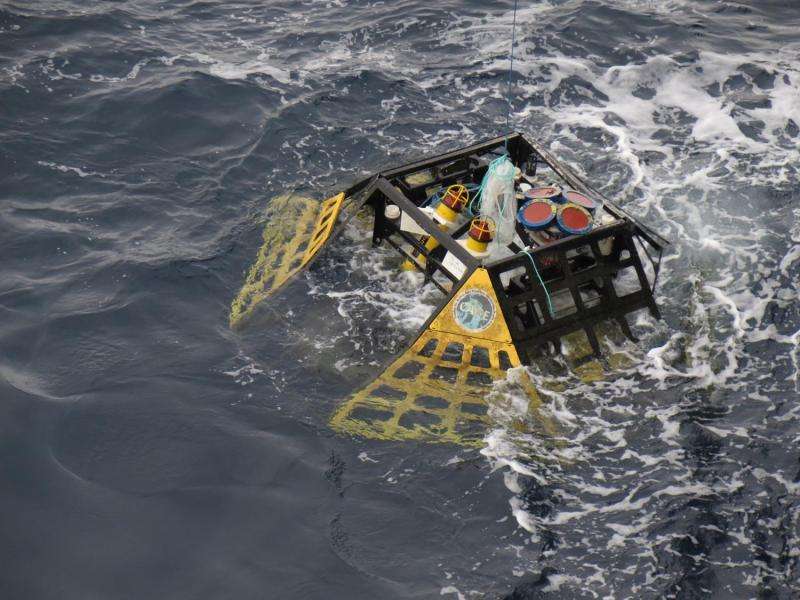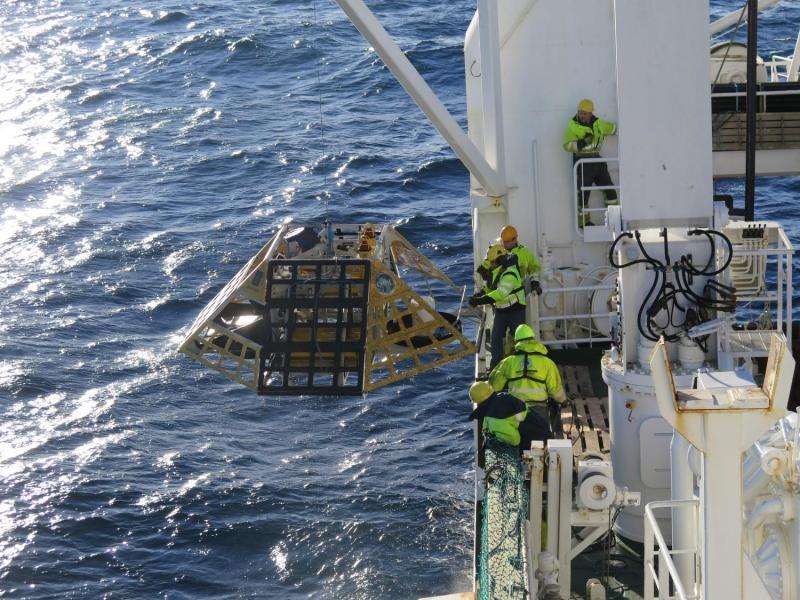Observatory retrieval from Arctic Ocean. Credit: Cage
Scientists from Centre for Arctic Gas Hydrate, Environment and Climate (CAGE) have recently retrieved two long-term observatories that have been sitting on the ocean floor in the Arctic for over a year. The recovery has been a success, yielding a year of unprecedented multi sensor data on Arctic methane release.
Mysteries still abound about methane release from the ocean floor. More than 250 flares release the greenhouse gas in relatively shallow areas offshore Svalbard, creating an ideal environment for ocean climate and long-term observations.
In close cooperation with CAGE, Kongsberg Maritime has developed two observatories, called K-Landers. The landers include instruments and sensors necessary to monitor the release of methane in ocean environment, evaluating potential causal effects within the ocean settings.
"The aim was to improve our understanding of one of the most dynamic and seasonally sea–ice influenced areas of natural seabed methane release. " says chief scientist Benedicte Ferré.
Deployed offshore Svalbard in 2015
The observatories were deployed offshore Svalbard in the spring of 2015, at depths of 90 and 240 meters, in an area of known gas release. A year later the suspense was high upon the retrieval of the landers – many things could have gone wrong under such harsh Arctic conditions. But with the help of the Research Vessel Helmer Hanssen both of the landers were successfully retrieved, and yes – they had recorded the data that they were set out to record.
Observatory retrieval from the Arctic Ocean. Credit: CAGE
"We are glad to say that we have already received some preliminary insights in data sets from our colleagues in Kongsberg." says Ferré who is satisfied with the collaboration with Kongsberg Maritime.
CAGE is currently increasing its oceanography team in ocean chemistry and dynamics, adding three new PhD positions to the research group led by Ferré. One of their main objectives will be to work with the retrieved data and put together the full story of methane release in a harsh ocean environment seasonally covered by sea ice in shallow waters.
Plans for redeployment in 2016
CAGE plans to redeploy the two K-Landers in the Arctic Ocean in 2016, after upgrades by Kongsberg Maritime, further increasing the capabilities of the systems.
"This pioneering way of exposing sensitive instrumentation to harsh environments, of course had its risks. But those were the risks one has to take to push the boundaries in scientific knowledge, and it has fortunately paid off. We are looking forward to developing the K-Landers further with our colleagues at Kongsberg Maritime to learn more about today' dynamic changes in the Arctic and possible future scenarios." Says CAGE director Jürgen Mienert.
Leaving highly sophisticated multi-sensor systems in the Arctic waters for a full year, is extremely challenging But:
"CAGE has provided the required expertise and guidance for Kongsberg Maritime to make this a success. The K-Lander has collected a complete annual cycle of multi-sensor data from the Arctic Ocean, which sets a new standard for long-term ocean observatories worldwide", states Sören Themann, Vice President of Subsea Monitoring at Kongsberg Maritime.
Provided by University of Tromso

























